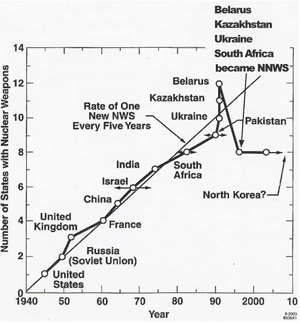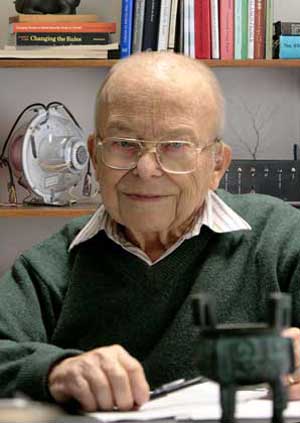Can Nuclear Proliferation be Stopped?*
The Fundamentals of Proliferation
Throughout the history of humanity, any new technology once invented and developed has diffused across the globe. Moreover, almost all new technologies have had dual use -- that is, they could be used to improve the human condition or they could be make the tools of violence even more destructive. We are now facing the inevitable sequel of this evolution as it relates to nuclear weapons. The world simply cannot afford to let nuclear weapons technology and acquisition diffuse all over the globe, considering the enormous destructive of even an individual nuclear explosive. So the historical tradition must be reversed in the case of nuclear weapons, but how is this to be accomplished?
The NPT Bargain
Recognizing the necessity of stemming nuclear weapons proliferation, numerous discussions and initiatives took place during the 1950’s and 1960’s. In 1953, President Eisenhower in his Atoms for Peace speech touted the benefits of nuclear power for peaceful goals, but expressed confidence that the military uses could be constrained.
Follow-on discussions led by the United States culminated in the signature in 1968 of the Nuclear Nonproliferation Treaty (NPT); a sufficient number of states ratified for the Treaty to come into force in 1970. The NPT established a complex bargain between Nuclear Weapons States (NWS) and Non-nuclear Weapons States (NNWS), with those terms designating states who had tested or not tested nuclear weapons by 1968. Non-nuclear Weapons States were enjoined from acquiring nuclear weapons and Nuclear Weapons States were forbidden to transfer nuclear weapons and the wherewithal to make them to an NNWS. To compensate for this obviously discriminatory division of the world’s nations into have’s and have-nots, NNWS received an “inalienable right” to the peaceful applications of nuclear energy, and the NWS obligated themselves in Article VI of the NPT to work in good faith towards nuclear disarmament.
The Challenge of the NPT Bargain
Not unexpectedly, some weaknesses in the NPT bargain had been evident since its creation. The NWS were unwilling to accept a designated timetable for nuclear disarmament and the NNWS were not restricted on the nature of the fuel cycle they were able to undertake in pursuit of civilian nuclear power. This latter failure to restrict the nuclear fuel cycle weakens the NPT through an evident technical factor: enrichment of natural uranium to low enriched uranium (LEU) produces the basic fuel for the vast majority of the world’s nuclear reactors today. Highly Enriched uranium (HEU) approaching 90% in the isotope U-235 additionally is an essential ingredient for most nuclear weapons; yet production of HEU and LEU requires the same technology. Additionally, spent fuel contains varying amounts of plutonium generated by neutron capture in the original fresh fuel in the reactor. Separating this plutonium from spent fuel, or reprocessing, together with enrichment can be interpreted to be part of the “inalienable right” to peaceful nuclear energy. Yet these processes clearly shorten the lead time for an NNWS to produce nuclear weapons, once it decides to withdraw from the Treaty or violate it.
The NPT provides that each party may withdraw after giving a 6 month notice stating its reasons for withdrawal. Thus a NNWS legally can make preparations to commence a dedicated nuclear weapons program after having acquired the nuclear fuel cycle technologies, including reprocessing or enrichment, and then withdraw from the Treaty.
The foregoing illustrates the risk that under the NPT, some of the NNWS might prepare for “breakout” from the nonproliferation regime while still complying with the NPT. But no less important is the very real risk that the NWS may flaunt their nonproliferation obligations. The problem here is that the the NPT does not define the obligations of the NWS in quantitative actionable terms.
Specifically, states such as the U.S. and Russia who substantially reduced their enormous nuclear weapons stockpiles but still retain many thousands of nuclear weapons, can and do claim that they are in compliance with the NPT. But the still enormous lethal holdings of nuclear weapons by the NWS make their pleas to the NNWS to forego nuclear weapons sound hypocritical, not unlike preaching abstinence while brandishing a glass of booze.
How Much Nuclear Weapons Proliferation to Date?

The growth in nuclear weapons states has been much slower than most knowledgeable analysts predicted several decades ago. The world is much better off in consequence of the enactment of the NPT.
The Current Threat
Notwithstanding the partial success of the NPT regime, threats to the endurance of that regime are accumulating. Three countries (India, Pakistan, and Israel) remain outside the Treaty, and North Korea withdrew from the Treaty after being accused of violations; currently, efforts are in progress to woo North Korea back into the fold.
Iran has invoked its “inalienable” right to pursue an enrichment program, and the Western powers accuse Iran of driving for nuclear weapons status; however everyone should recognize that maintaining an option for future nuclear weapons acquisition and definitely intending to do so are not the same. We also note that Brazil continues its enrichment program notwithstanding its ample supply of hydroelectric power. Japan has accumulated over 40 tons of separated plutonium, one-tenth of which is located in Japan with the rest remaining in Europe. Thus, all these states might be considered “latent proliferators.”
The foregoing troubling developments relate to the NNWS. In parallel, the NWS claim to be in compliance with their obligation under Article VI of the NPT to proceed towards nuclear disarmament, yet all of them are operating programs which signal to the world that they are depending on nuclear weapons for their security for the indefinite future. Only China has officially declared a No First Use Policy, that is a policy not to use nuclear weapons unless attacked with nuclear weapons first.
The NPT provides for Review Conferences of the working of the NPT every five years following preparatory meetings. During the 1995 Review Conference the NPT was converted to a Treaty of indefinite duration. However, the most recent Review Conferences have been acrimonious, exhibiting the sharp division between the NWSs maintaining to be in full compliance with the NPT and the NNWS complaining about its discriminatory aspects.
Remedies to Threats to the Nonproliferation Regime
No single “silver bullet” can remove the inherent tensions, contradictions and risks of latent or outright violations inherent in the NPT regime. But much can and should be done to reduce the risks. The dominant need is to deemphasize the role of nuclear weapons in international security affairs. As the unquestioned leader in conventional armaments, the United States has most to gain by strengthening the NPT regime since the US can deal with essentially all non-nuclear threats by conventional, that is, non-nuclear means. The United States has the most to lose if new Nuclear Weapons States emerge. Nuclear weapons are the “great equalizer” : even a handful of nuclear weapons dramatically increases the political leverage of a present NNWS in relation to the United States.
The United States should convert its present ambiguous nuclear weapons policies to a simple doctrine that the only justifiable remaining mission of nuclear weapons is to deter the use of nuclear weapons by others. Under such a narrow doctrine, the United States could drastically reduce its stockpiles beyond its present numbers. Renewed vigor to negotiations with Russia to reduce their excessive nuclear forces should follow. In particular the large number of tactical nuclear weapons and weapons held in reserve should be brought under control.
Civilian nuclear power is justifiably slated for a major revival, together with its inherent proliferation risks. The NPT requires each NNWS to negotiate an agreement with the International Atomic Energy Agency to provide for “safeguards,” that is, an inspection regime designed to prevent diversionary activities. Despite the efforts to redesign the relevant technologies there is no such thing as a “proliferation-proof” nuclear fuel cycle; the various approaches only differ by the level of safeguarding required to prevent diversion. The important element should be transparency which publicly links the fuel cycle activities to a reasonable nuclear energy program. Beyond that, the only possible remedy is to internationalize the enrichment and reprocessing components of the nuclear field cycle by having those elements under ownership and control of an international agency which guarantees an assured supply of low enriched fuel to all states while providing for safeguards of the nuclear facilities. Selective enforcement arrangements among “coalitions of the willing” to restrict transfer of nuclear materials will only perpetuate the discriminatory pattern.
But above all, proliferation can be stopped only if motivation to nuclear proliferation can be curtailed through an increasing emphasis on diplomatic solutions to resolve conflict and a de-emphasis of violence, in particular, violence using nuclear weapons.
*An earlier version of this article first appeared in The Bulletin Online on August 3, 2007.

Sidney Drell, Deputy Director Emeritus, Stanford Linear Accelerator Center
Wolfgang K.H. Panofsky (known universally as Pief) died at home of a heart attack on September 24, 2007 at the age of 88. Recognized worldwide as a great physicist and the founding Director of the Stanford Linear Accelerator Center, Pief was also influential in advising the government and speaking out publicly on major issues of national security and arms control, particularly concerning nuclear weapons. His contributions on national security, that started during the Eisenhower administration when he led a technical study on the ability to verify a ban on explosive testing of nuclear weapons in space, continued to the very end of his life. In fact he spent the day he died in his office working and writing about his concerns of nuclear proliferation and urging major reductions and eventual elimination of nuclear weapons. He was also eagerly anticipating the publication the following week of his recently completed informal autobiography “Panofsky and Physics, Politics and Peace: Pief Remembers.” Above all Pief will be remembered as a beloved leader of modern physics with a warm humanity, and uncompromising integrity and commitment to principles in which he deeply believed.
